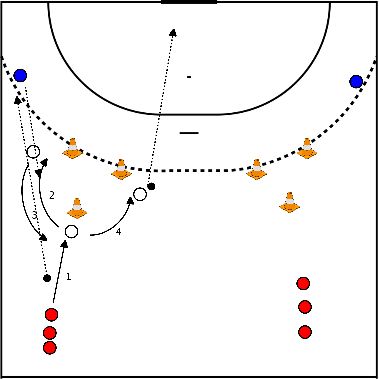Handball drills for technique attack / offense
This is a coordinated minus tempo attack to create a lot of space on the wings and shoot freely.
- The back players rotate the ball wing to wing to displace the defenders.
- When the play gets called "Minus tempo Left/Right" this means it will be the left or the right winger to shoot.
- If the call is Minus tempo right, then it will be the right winger to shoot, as in the example below.
- The first step is the pivot places themselves on the 3 defender, near the left back, displacing the central defenders slightly to their right already.
- The right winger then goes deep to near the corner flag to open up as much as possible.
- The left back passes to the left wing, who passes back to the left back, passing to the centre, to the right back, to the centre back again, back to left back, and back to left wing. All these passes will create space by themselves.
- Once the ball leaves the left wing again, the left back makes a run to goal with the ball attacking between 2 and 3, the centre back does the same attacking around the other 3, and the right back as well attacking between 2 and 1, closer to 2.
- These runs have to be coordinated to displace all defenders. This will make it so the defenders 1 and 2 on the right side will close on the right back, and the wing will be free.
- The left back then jumps and passes across the court to the free winger who has started running and has enough momentum and angle to score.
- If the defenders don't move then there's several other finishing options. If the second 3 defender doesn't close the pivot, the pivot will be free.
- If the second 3 closes the pivot, but the 2 defender doesn't close on the centre back run, then the centre can score. If the 2 defender closes but the 1 defender doesn't close, then the right back scores.
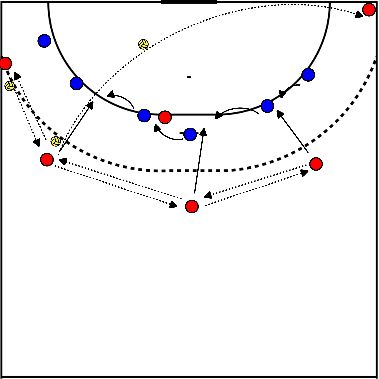
This is a resistance and mental strength exercise.
- Each player goes to their position. They will have to take 3 - 5 shots in a row, running back to the position as soon as they shoot. For every two shots, they will have to change the third shot.
- The objective, more than building resistance, is to build mental strength to make the body go forward when we're tired.
- This will be repeated several times.
- The first couple of times the players won't be tired, but after the third or fourth repetition of the series of shots in a row, then they will.
- There can also be one player (pivot for example) blocking shots (not 100% defense, just 30%)
- If the overall team scores more than 50% than the keeper does 20 push ups, 20 sit ups, and 20 squats.
- If the team scores less than, then the team does it.
The players form a line at one end of the court.
- The 2nd player on the line passes the ball to the coach who will be between the centre of the court and the 12 meters.
- The 1st player on the line runs as soon as the pass is made.
- The coach will then pass the ball to the front of the 1st player who is running towards the opposite goal to receive the ball.
- The pass will not be towards the player's hands, but rather to a step in front of where they are, so they continue accelerating.
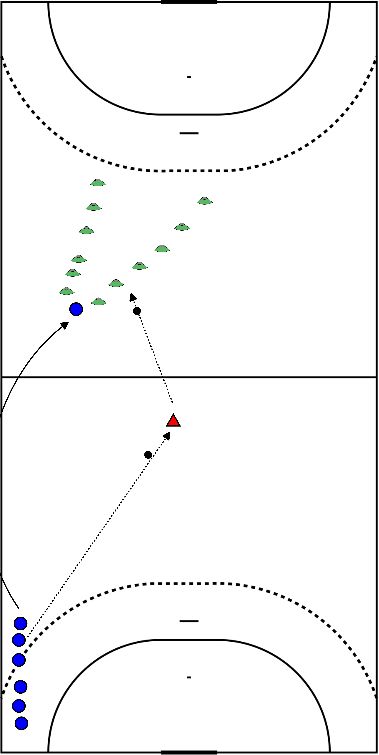
- This can be done with groups of 5 up to 9.
- Let's take a group of 7
- Delineate an area where 4 people can stand and move around with a bit (not too much) room. Place 3 defenders inside, plus 1 line/pivot.
- The remaining 3 attackers will pass the ball around outside the area, with no bounce, and they score a point by either:
- Passing the ball effectively to the pivot
- Placing the ball inside the area without being touched by a defender
- The attackers can move freely, but limited to the 3 steps, 3 seconds with ball in hand, and no bounce.
- If these rules are broken, they become the defenders.
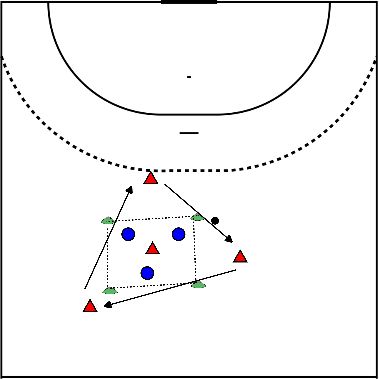
This can be done in groups of 2 or 3 players.
- This is to get used to receiving the ball in motion, facing the goal.
- This is a passing exercise as well.
- Let's take a group of 3 players.
- There will be two cones on the floor, at around 10 meters, on each side of the centre back, and 2 cones at the 7 meters in front of the half backs.
- The centre back has the ball, and for the half back to receive the ball, they need to start behind the cone of the 10 meters, and run in front of it.
- The centre back can only pass the ball in the direction after the cone. Once the half back receives the ball, they will do two/three steps towards the 7 meter cone, stop, and pass the ball back to the centre half who must start before the 10 meter cone and receive the ball after it.
- The half back then returns to their spot and the centre back continues the exercise with the other side half back.
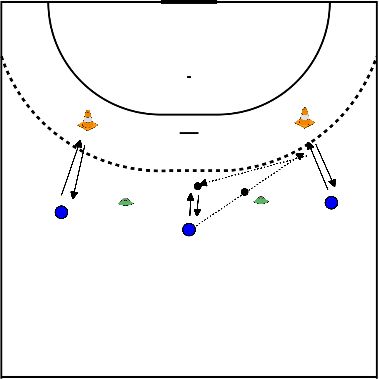
- Depending on how many players there are you can use the full 6/9 meters or just a part of it.
- The defending players will hold hands two by two (so if there are 6 players, there will be 3 groups of 2).
- The attacking players will pass the ball around between themselves and around the area trying to "destabilise" the defence and find a gap so they can run in and touch down with the ball in the area.
- If the 2 groups of the defending players touch the attacker, the point does not count.
- if only 1 of the groups of the defending players touch the attacker, the point counts.
- If none of the groups of the defending players touch the attacker, it counts 2 points.
The goal is to get to 8/10 points (depending on how many 2 points they score) and then swap.
- If there's few players, shorten the court and if there's an uneven number, the defence stays with one less.
Pay attention:
- No lob passes
- No more than 3 passes
- No bounce (if possible)
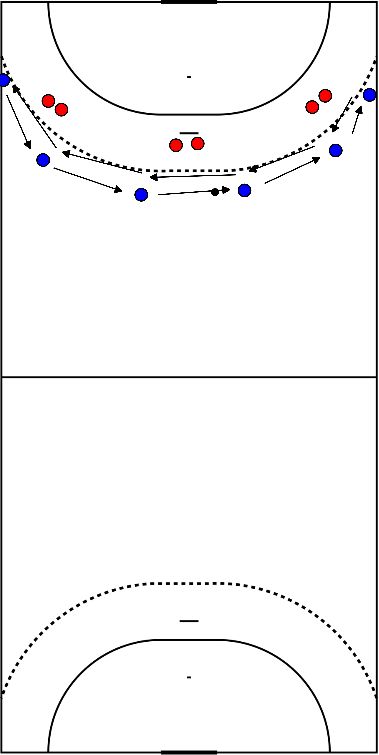
This can be done with groups of 3 to 7 - odd numbers ideally.
- Let's assume a group of 5 players.
- We'll have 3 attackers and 2 defenders.
- The 3 attackers will have a delimited running corridor in a straight line and they will have to pass the ball from one to the others while the 2 defenders will have to try and intercept the passes. The defenders have freedom of movement.
- The exercise can evolve in the types of passes in order to foster movement without the ball.
- First all types of pass, then no lob passes, then only bounce passes.
If the defenders intercept the pass, they continue the exercise acting as the attacking players in numerical inferiority. The 3 attacking players now have no restriction of movement.
This is to be done slowly at first, not as a fast break, to instill the idea of moving without the ball first. The speed can be adapted as the exercise goes on.
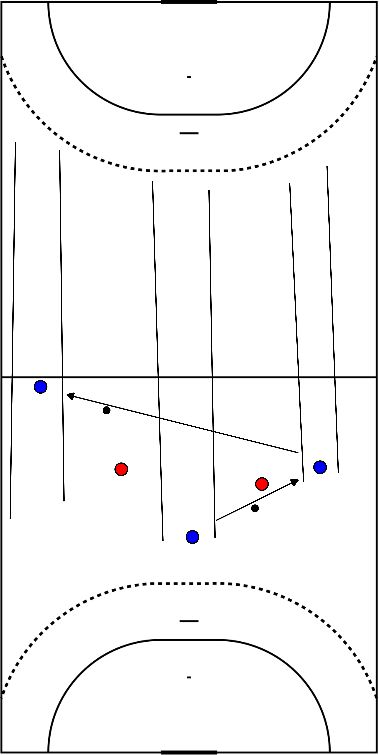
- Little 8 is the change of circle with the corner players.
- Middle build-up indicates which system is started. At small 8 the corners and circle start running;
- The right corner takes the initiative and runs towards the position of the circle (can be with or without ball!), the circle runs towards the corner and perhaps takes a defender with it. This may free up the circle which can be played through the build-up. If not, the substitute moves on to the other corner, until either a goal is scored or everyone is back in his/her own place.
- Important is watching each other's timing, not getting in each other's way and correct passing with bounce by the builder.
- Practice start with passive defenders, then active
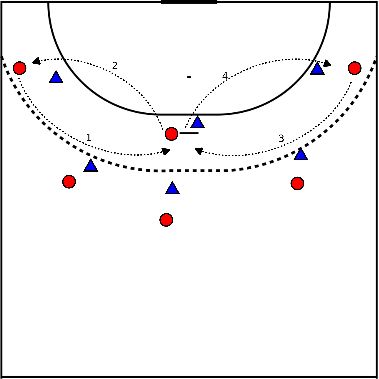
Divide team into 3 teams.
- Team 1 starts defending
- Team 2 starts attacking from the middle
- Team 3 gets ready on the middle line with ball
Once completed, team 2 starts defending and the 3rd team starts attacking from the middle.
- Team 1 takes the ball and gets ready on the middle line, etc.
The goal is to switch quickly from attacking to defending.
All positions at least occupied by 1 player with ball
On follow order is completed:
On follow order is completed:
- Right corner: round off with lop
- Right formation: round off with underhand shot (possibly 2 boxes with mat to create opening)
- Center formation: round off with jump shot over an F goal/mat (this is at 9 m)
- Left formation: round off with a dummy around the post
- Left corner: free choice of rounding
- Circle runner: turn and jump with 2 legs at the same time
Having rounded off choose another position
Goalkeeper gets a vest which he/she throws up, holds up ball and must catch the vest before it hits the ground. (or holds balloon in the air during exercise) Pay attention to goalkeeper posture (hands high, knees bent)
Goalkeeper gets a vest which he/she throws up, holds up ball and must catch the vest before it hits the ground. (or holds balloon in the air during exercise) Pay attention to goalkeeper posture (hands high, knees bent)
- Middle build-up indicates moment and system starts at Left corner
- Right corner goes deep
- Right corner takes up its position more to the right and applies pressure
- Left corner puts pressure
- Left corner puts pressure and walks backwards
- Center structure puts pressure on the left with the aim of taking center defender with it and then barricading/holding it with it
- Circle runner secures circle defender
- Left post runs behind Center post and receives the ball
Note: Right corner and Right build-up also put pressure to the right to keep defender with them so that Left build-up gets space
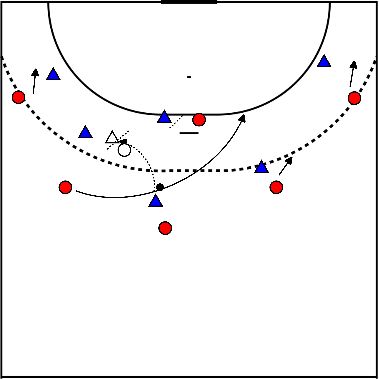
Goal of the exercise
- In this exercise, we improve our footwork during pressure and in rounding.
Exercise
- On the buildup positions, 3 pylons are in the point to the back.
- The 2 front pylons are at the 9 meter mark.
- One focal point stand beyond the pylon in the middle.
- Players play the point of attack and run without the ball towards the left pylon, in the forward motion they play the ball, in the backward motion they get it back.
- Players run around the back pylon and push again, this time they finish on goal
Variation
- Exercise can be performed at left build and right build position at the same time.
- After finishing, switch sides.
